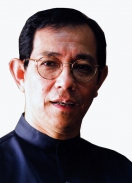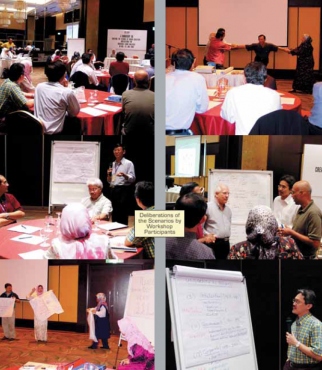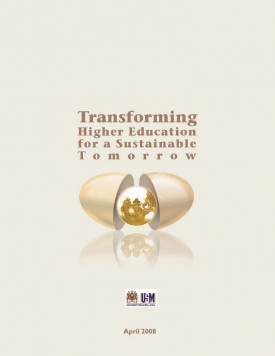Response to Discourse on Global Higher Education
Professor Tan Sri Dato' Dzulkifli Abd Razak
Comment
GlobalHigherEd - 08/27/2010
Editors’ note: today’s guest entry has been kindly developed by Professor Dzulkifli Abdul Razak, Vice-Chancellor, Universiti Sains Malaysia, a position he has held since 2000. Professor Dzulkifli’s post is the seventh response to Nigel Thrift’s ‘A question (about universities, global challenges, and an organizational, ethical dilemma)‘, which was originally posted on 8 April 2010. As noted in last week’s entry (‘A Columbia University/Millennium Promise response to ‘A question (about universities, global challenges, and an organizational-ethical dilemma)”, we are accepting contributions to the discussion through to the end of 2010.

Professor Dzulkifli Abdul Razak (pictured to the right) is presently serving as Vice-President of the International Association of Universities (IAU) - a UNESCO- affiliated organisation. He served as President of Association of Southeast Asia Institutions of Higher Learning (ASAIHL) from 2007-2008, and is also a member of Asia-Europe Meeting (ASEM) – Advisory Education Hub Committee, Executive Council of Association of Commonwealth Universities (ACU), and also Advisory Committee of World Universities Forum (WUF). He has served as a World Heath Organisation (WHO) Expert Advisory Panel on Drug Policies and Management since 1995, and the WHO Scientific Advisory Committee on Tobacco Product Regulation (2000-2002). At the national level, he is the Chair of Malaysian Vice-Chancellors’/Rector’s Committee, and Chair of Malaysian Examination Council, Co-chair of Malaysian and serves as Advisor to the National Higher Education Research Institute (IPPTN). Outside the academic arena, he writes regularly for his weekly column in the New Straits Times, and, fortnightly, in The Edge, where he shares his views on a host of national and global issues.
Our sincere thanks to Professor Dzulkifli Abdul Razak for developing this illuminating entry, and the first response on behalf of an Asian university.I cannot agree more with Nigel Thrift when he posed ‘A question (about universities, global challenges, and an organizational, ethical dilemma)‘. Coming from the Global South invariably this question resonates with me, more so in articulating the raison d’être of a university in the 21st century. In short, is a university modelled on the days of the industrial age – taking more or less a metaphor of factory – still relevant for the post-industrial age with its unique global challenges and ethical dilemma? In other words, can a factory-like metaphor with its de-humanizing tendencies adequately support for the future? What James Martin termed as “The 21st Century Revolution.”
Our search for “answers” to such a question started with a Scenario Planning Workshop in May 2005. It seeks to understand what would the scenario for a university be in the year 2025? We came out with six scenarios, including a “Dead University” scenario – where the present setup fails to respond to the need of the future! This scenario is discarded since we are desirous to bring about a change; but the question is: which way forward?

After almost 15 months of university-wide consultations and soul-searching activities, backed by the emerging trends globally – not much different from that of Thrift’s, only more intense, we agreed on “The University in a Garden “ scenario – which is now the tagline of the University (see Universiti Sains Malaysia’s publication: Constructing Future Higher Education Scenarios – Insights from Universiti Sains Malaysia, 2007 (a review of this report can be downloaded here).
In summary, Constructing Future Higher Education Scenarios – Insights from Universiti Sains Malaysia concerns itself with creating a sustainable future, and how university must change to cope with this new future. Here the focus is about the prevailing disparities in all facets of societal well-being as depicted by the United Nation Millennium Development Goals (MDGs), which will end in 2015 – barely five years from now. Most of the MDGs are age-old issues of extreme poverty, very simple and common diseases, basic education, malnourishment and hunger, infant and maternal health and mortality – many of which are no longer heard of in the Global North! Yet, they are very real in the South with all its accompanying shortcomings and vulnerabilities. Interestingly the last and eighth goal of MDGs is about Global Partnership! But, what kind of partnership and for what purpose? It comes back to the question what are universities for in the 21st century!
To be sure, it is more an issue of awareness and will, than knowledge or technology. Many of challenges posed by MDGs can be solved, if there is a will to share based on a truly global partnership. To quote the UN Secretary-General in his called for a special UN Summit in September 20-22, 2010: “Our world possesses the knowledge and the resources to achieve the MDGs. Our challenge today is to agree on an action agenda to achieve the MDGs.” Similarly for the universities that are keen in such a mission! First off, how many universities have MDGs on their radar screen as part of the educational framework?; let alone directed to fulfilling such global agenda. Perhaps, this is one of the organizational-ethical dilemmas alluded to by Thrift. Indeed, how many more have missed the UN Decade of Education for Sustainable Development that was launched in 2005 (coinciding with USM Scenario Planning initiative) as a way to engage in elucidating this dilemma.

In that context, USM has taken a new approach with a new vision: Transforming Higher Education for a Sustainable Tomorrow. This is part of a larger agenda to redefine “excellence” in line with the challenges of the future under Malaysia’s Accelerated Programme for Excellence (APEX) of which USM is currently undergoing. In so doing we recognized the distraction that Thrift referred to when he wrote: “…as if their [universities] chief raison d’être is position in the league tables. To complete the triptych of problems, it is still too often assumed that scientific discovery, which nearly always takes place as part of a network of actors distributed across the globe, is the province of an individual actor anchored in a particular place: think only of the system of prizes and awards.” As such, our new mission now reads: “USM is a pioneering, transdisciplinary research intensive university that empowers future talents and enables the bottom billions to transform their socio-economic well-being.”
This is our second year on the APEX journey, and we are gradually discovering that the factory-like metaphor is in main dysfunctional to serve the need for the future, at least in the Global South. In that regards the question raised by Thrift can only be adequately articulated if we are bold enough to create a new metaphor for the university of the future! Short of that, the “Dead University” scenario as mentioned above may seem more likely.
* The writer is the Vice-Chancellor of Universiti Sains Malaysia. He can be contacted at vc@usm.my
Comment
GlobalHigherEd - 08/27/2010
Editors’ note: today’s guest entry has been kindly developed by Professor Dzulkifli Abdul Razak, Vice-Chancellor, Universiti Sains Malaysia, a position he has held since 2000. Professor Dzulkifli’s post is the seventh response to Nigel Thrift’s ‘A question (about universities, global challenges, and an organizational, ethical dilemma)‘, which was originally posted on 8 April 2010. As noted in last week’s entry (‘A Columbia University/Millennium Promise response to ‘A question (about universities, global challenges, and an organizational-ethical dilemma)”, we are accepting contributions to the discussion through to the end of 2010.

Professor Dzulkifli Abdul Razak (pictured to the right) is presently serving as Vice-President of the International Association of Universities (IAU) - a UNESCO- affiliated organisation. He served as President of Association of Southeast Asia Institutions of Higher Learning (ASAIHL) from 2007-2008, and is also a member of Asia-Europe Meeting (ASEM) – Advisory Education Hub Committee, Executive Council of Association of Commonwealth Universities (ACU), and also Advisory Committee of World Universities Forum (WUF). He has served as a World Heath Organisation (WHO) Expert Advisory Panel on Drug Policies and Management since 1995, and the WHO Scientific Advisory Committee on Tobacco Product Regulation (2000-2002). At the national level, he is the Chair of Malaysian Vice-Chancellors’/Rector’s Committee, and Chair of Malaysian Examination Council, Co-chair of Malaysian and serves as Advisor to the National Higher Education Research Institute (IPPTN). Outside the academic arena, he writes regularly for his weekly column in the New Straits Times, and, fortnightly, in The Edge, where he shares his views on a host of national and global issues.
Our sincere thanks to Professor Dzulkifli Abdul Razak for developing this illuminating entry, and the first response on behalf of an Asian university.I cannot agree more with Nigel Thrift when he posed ‘A question (about universities, global challenges, and an organizational, ethical dilemma)‘. Coming from the Global South invariably this question resonates with me, more so in articulating the raison d’être of a university in the 21st century. In short, is a university modelled on the days of the industrial age – taking more or less a metaphor of factory – still relevant for the post-industrial age with its unique global challenges and ethical dilemma? In other words, can a factory-like metaphor with its de-humanizing tendencies adequately support for the future? What James Martin termed as “The 21st Century Revolution.”
Our search for “answers” to such a question started with a Scenario Planning Workshop in May 2005. It seeks to understand what would the scenario for a university be in the year 2025? We came out with six scenarios, including a “Dead University” scenario – where the present setup fails to respond to the need of the future! This scenario is discarded since we are desirous to bring about a change; but the question is: which way forward?

After almost 15 months of university-wide consultations and soul-searching activities, backed by the emerging trends globally – not much different from that of Thrift’s, only more intense, we agreed on “The University in a Garden “ scenario – which is now the tagline of the University (see Universiti Sains Malaysia’s publication: Constructing Future Higher Education Scenarios – Insights from Universiti Sains Malaysia, 2007 (a review of this report can be downloaded here).
In summary, Constructing Future Higher Education Scenarios – Insights from Universiti Sains Malaysia concerns itself with creating a sustainable future, and how university must change to cope with this new future. Here the focus is about the prevailing disparities in all facets of societal well-being as depicted by the United Nation Millennium Development Goals (MDGs), which will end in 2015 – barely five years from now. Most of the MDGs are age-old issues of extreme poverty, very simple and common diseases, basic education, malnourishment and hunger, infant and maternal health and mortality – many of which are no longer heard of in the Global North! Yet, they are very real in the South with all its accompanying shortcomings and vulnerabilities. Interestingly the last and eighth goal of MDGs is about Global Partnership! But, what kind of partnership and for what purpose? It comes back to the question what are universities for in the 21st century!
To be sure, it is more an issue of awareness and will, than knowledge or technology. Many of challenges posed by MDGs can be solved, if there is a will to share based on a truly global partnership. To quote the UN Secretary-General in his called for a special UN Summit in September 20-22, 2010: “Our world possesses the knowledge and the resources to achieve the MDGs. Our challenge today is to agree on an action agenda to achieve the MDGs.” Similarly for the universities that are keen in such a mission! First off, how many universities have MDGs on their radar screen as part of the educational framework?; let alone directed to fulfilling such global agenda. Perhaps, this is one of the organizational-ethical dilemmas alluded to by Thrift. Indeed, how many more have missed the UN Decade of Education for Sustainable Development that was launched in 2005 (coinciding with USM Scenario Planning initiative) as a way to engage in elucidating this dilemma.

In that context, USM has taken a new approach with a new vision: Transforming Higher Education for a Sustainable Tomorrow. This is part of a larger agenda to redefine “excellence” in line with the challenges of the future under Malaysia’s Accelerated Programme for Excellence (APEX) of which USM is currently undergoing. In so doing we recognized the distraction that Thrift referred to when he wrote: “…as if their [universities] chief raison d’être is position in the league tables. To complete the triptych of problems, it is still too often assumed that scientific discovery, which nearly always takes place as part of a network of actors distributed across the globe, is the province of an individual actor anchored in a particular place: think only of the system of prizes and awards.” As such, our new mission now reads: “USM is a pioneering, transdisciplinary research intensive university that empowers future talents and enables the bottom billions to transform their socio-economic well-being.”
This is our second year on the APEX journey, and we are gradually discovering that the factory-like metaphor is in main dysfunctional to serve the need for the future, at least in the Global South. In that regards the question raised by Thrift can only be adequately articulated if we are bold enough to create a new metaphor for the university of the future! Short of that, the “Dead University” scenario as mentioned above may seem more likely.
* The writer is the Vice-Chancellor of Universiti Sains Malaysia. He can be contacted at vc@usm.my
